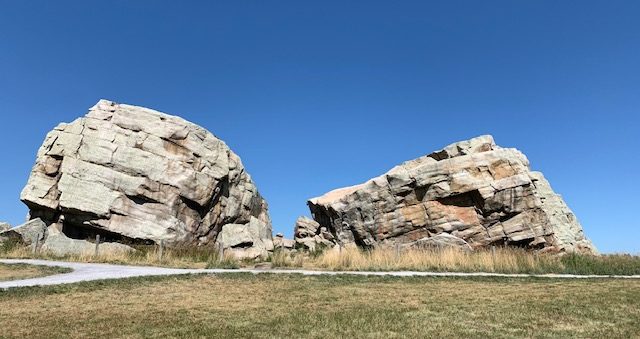I love to travel and this summer the plan was to spend a few weeks in Belize, exploring the rainforest and reefs, with a bit of time to relax on the beach with a good book and a cold beverage. But then Covid… I trust that Belize will still be there when we can travel again.
So, instead of Belize, I got Alberta! I’ve lived in Alberta my whole life and this summer a friend and I spent a couple of weeks driving highways I’d never been on, visiting small towns along the way, and witnessing the artistic genius of our Creator.
One of the stops we made was to see a big rock in the middle of a field: the Okotoks Erratic. For those who have not taught a geology course lately, an erratic is a glacially deposited rock that is different from the native rock in the area. Erratics range in size, and the one near Okotoks is huge.
There is a fence around the erratic so that people don’t climb on it. Now, I will admit, it is a Canadian-type fence: just a knee-high barrier with a single chain going from post to post, trusting people to comply rather than preventing entry. Easy to step over, but also clearly indicating that you’re not supposed to enter the area.
As we approached the erratic, we noticed several people climbing on the rock and as we neared, we saw mostly kids from a variety of families scampering about as their parents watched from the path. This got me wondering: why would people feel the permission to jump (well, step over!) the fence and climb the rock when it was clearly not allowed? Or maybe more frustrating to a teacher: why would parents allow their kids to do this?
Now fast forward a few days on vacation to another natural wonder, where a similar fence was enough to keep people on the path. Nobody ventured where they weren’t supposed to be. What was the difference? Why were people’ actions so different in the different situations?
I think the difference was leadership. As soon as one person took the initiative to step over the fence and climb the erratic, when the next family arrived, it was easier for those parents to allow their children to do the same. Even though the signage and fence made it very clear what was supposed to be done, seeing someone doing something different, gave the next visitors both permission and courage to follow suit. So up and over the fence they went. At the other site we visited, there was no one “brave” enough to be the first over the fence and as a result, we all marveled at the wonder from an appropriate vantage point.
Although I think it’s pretty clear that this leadership was not the positive kind we hope for, we can still still learn some Erratic Leadership lessons:
- Sometimes you need to be brave enough to take a step into territory others aren’t willing to do. Just like on the erratic, it takes one person brave enough to step outside the norm and explore some new territory. This can be a scary adventure, as you can’t be sure about the dangers ahead and sometimes, you’re venturing into uncharted territory. It’s challenging work, but if no one is willing to take a risk, we’ll never know what the view looks like from the top.
- Ensure you engage your gift of discernment when deciding where to lead your people. You don’t want to be the leader taking your followers to places they shouldn’t be going. The view from the top may be spectacular, but if on the way you break a leg, squish some rare wildflowers or get fined for trespassing, you were probably not supposed to in the area. Use the influence you have in positive ways.
- You don’t always need to be the first one over the fence. Sometimes having the humility to follow someone ahead of you is great leadership. In our erratic situation, the first person over the fence was just a rule-breaking selfish clod. It took the next person to follow suit before something significant began to happen. Then it became easier and easier for all the rest to step across the fence and join in. It took one adventurous soul to start things off, a few more brave followers to join in, and a movement was begun! Be on the lookout for someone taking a risk in the right direction and put your support behind them. That support may be just the thing needed to make the difference!
Who knew you could learn some important leadership lessons from a big old rock in the middle of the prairie?!



